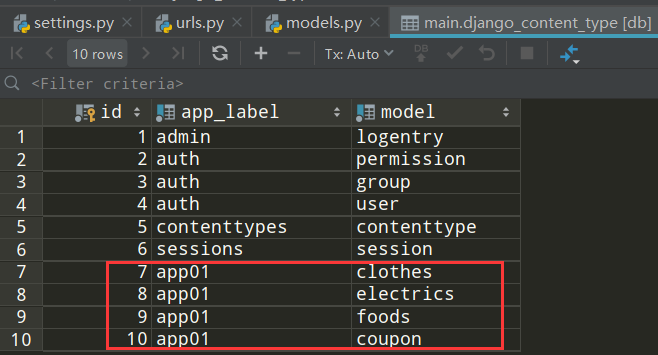Django基础之ContentType
一. 简介
contenttypes 是Django内置的一个应用,可以追踪项目中所有app和model的对应关系,并记录在ContentType表中。
models.py文件的表结构写好后,通过makemigrations和migrate两条命令迁移数据后,在数据库中会自动生成一个django_content_type表。
表:
from django.db import models # Create your models here. from django.db import models class Electrics(models.Model): """ id name 1 日立冰箱 2 三星电视 3 小天鹅洗衣机 """ name = models.CharField(max_length=32) class Foods(models.Model): """ id name 1 面包 2 烤鸭 """ name = models.CharField(max_length=32) class Clothes(models.Model): name = models.CharField(max_length=32) class Coupon(models.Model): # 特殊关系表 """ id name electric_id food_id cloth_id more... # 每增加一张表,关系表的结构就要多加一个字段。 1 通用优惠券 null null null 2 冰箱满减券 2 null null 3 面包狂欢节 null 1 null """ name = models.CharField(max_length=32) electric = models.ForeignKey(to='Electrics', null=True, on_delete=models.CASCADE) food = models.ForeignKey(to='Foods', null=True, on_delete=models.CASCADE) cloth = models.ForeignKey(to='Clothes', null=True, on_delete=models.CASCADE)
如果是通用优惠券,那么所有的ForeignKey为null,如果仅限某些商品,那么对应商品ForeignKey记录该商品的id,不相关的记录为null。但是这样做是有问题的:实际中商品品类繁多,而且很可能还会持续增加,那么优惠券表中的外键将越来越多,但是每条记录仅使用其中的一个或某几个外键字段。
contenttypes 应用
通过使用contenttypes 应用中提供的特殊字段GenericForeignKey,我们可以很好的解决这个问题。只需要以下三步:
在model中定义ForeignKey字段,并关联到ContentType表。通常这个字段命名为“content_type”
在model中定义PositiveIntegerField字段,用来存储关联表中的主键。通常这个字段命名为“object_id”
在model中定义GenericForeignKey字段,传入上述两个字段的名字。
为了更方便查询商品的优惠券,我们还可以在商品类中通过GenericRelation字段定义反向关系。

models:
from django.db import models from django.contrib.contenttypes.models import ContentType from django.contrib.contenttypes.fields import GenericForeignKey, GenericRelation class Electrics(models.Model): name = models.CharField(max_length=32) price = models.IntegerField(default=100) coupons = GenericRelation(to='Coupon') # 用于反向查询,不会生成表字段 def __str__(self): return self.name class Foods(models.Model): name = models.CharField(max_length=32) price=models.IntegerField(default=100) coupons = GenericRelation(to='Coupon') def __str__(self): return self.name class Clothes(models.Model): name = models.CharField(max_length=32) price = models.IntegerField(default=100) coupons = GenericRelation(to='Coupon') def __str__(self): return self.name class bed(models.Model): name = models.CharField(max_length=32) price = models.IntegerField(default=100) coupons = GenericRelation(to='Coupon') class Coupon(models.Model): """ Coupon id name content_type_id object_id_id 美的满减优惠券 9(电器表electrics) 3 猪蹄买一送一优惠券 10 2 南极被子买200减50优惠券 11 1 """ name = models.CharField(max_length=32) content_type = models.ForeignKey(to=ContentType,on_delete=models.CASCADE) # step 1 既然没有直接和关联表进行外键关系,我们通过这一步先找到关联表 object_id = models.PositiveIntegerField() # step 2 #存的是关联的那个表的对应的那条记录的id content_object = GenericForeignKey('content_type', 'object_id') # step 3 对象.content_object直接就拿到了这个优惠券对象关联的那个商品记录对象。 def __str__(self): return self.name
相关操作:
创建记录和查询 from django.shortcuts import render, HttpResponse from api import models from django.contrib.contenttypes.models import ContentType def test(request): if request.method == 'GET': # ContentType表对象有model_class() 方法,取到对应model content = ContentType.objects.filter(app_label='api', model='electrics').first() # 表名小写 cloth_class = content.model_class() # cloth_class 就相当于models.Electrics res = cloth_class.objects.all() print(res) # 为三星电视(id=2)创建一条优惠记录 s_tv = models.Electrics.objects.filter(id=2).first() models.Coupon.objects.create(name='电视优惠券', content_object=s_tv) # 查询优惠券(id=1)绑定了哪个商品 coupon_obj = models.Coupon.objects.filter(id=1).first() prod = coupon_obj.content_object print(prod) # 查询三星电视(id=2)的所有优惠券 res = s_tv.coupons.all() print(res)



 浙公网安备 33010602011771号
浙公网安备 33010602011771号